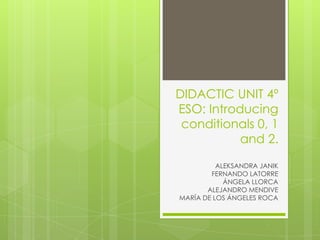
Introducing Conditionals in ESO 4
- 1. DIDACTIC UNIT 4º ESO: Introducing conditionals 0, 1 and 2. ALEKSANDRA JANIK FERNANDO LATORRE ÁNGELA LLORCA ALEJANDRO MENDIVE MARÍA DE LOS ÁNGELES ROCA
- 2. General aspects LEVEL: 4º ESO TYPE OF SCHOOL: State school TIME DISTRIBUTION: 3 sessions of one hour Regarding the organisation of the sessions, we have considered useful to firstly provide the students with real examples of English, in order to make them deduce what new features of the language are happening. Afterwards, when the students are aware of them and have used them with some exercises, theory will be explained to them. We believe in a deductive way of learning, rather than explaining cold grammar from the very beginning.
- 3. Session 1 1.- Text on 0 and 1st conditionals (15’) Students should underline the conditional sentences and then compare them with a fellow student. 2.- Grammar explanation (10’) In a dynamic and deductive way. 3.- Multiple choice exercise (15’) Students should be able to link two phrases of a sentence in order to make them make sense 4.- “Complete the sentence” exercise (10’) This exercise is useful to reinforce and to settle down the new information.
- 4. Session 2 1.- Speaking about “The Fiddler on the Roof” (7’) Students will be asked some questions about him and they will provide answers in groups of 4 students. 2.- Video-listening (15’) The song of “The Fiddler…”. They will be asked some questions about the content of the song. 3.- Grammar explanation (10’) In a dynamic and deductive way. 4.- Listening: “If I were a boy” – Beyoncé (10’) Fill in the gaps exercise. 5.- Writing and singing (13’) In groups of 4 boys or 4 girls, they try to create new lyrics for an specific part of the song. They try to write something about the other sex, not in an offensive way at all. Something good or funny.
- 5. Session 3 1.- Warm-up activity (15’) In groups of 4 students, they will try to establish the grammatical rules of the conditionals. They will write three sentence each and put them in common out loud. 2.- Grammar (written and spoken) practice (20’) With games. 3.- Test (15’) This is not a final exam, just a test to check if the students have learnt the conditionals.
- 6. Content Specific and Language system basic and didactic competences objectives 0- Expressing Learning: open condition 1-Conditional sentences: 0, 1st, and 2nd type 1-Hypothesising Through the use of: 2-Expressing 2- Future tense unreal 3-Simple conditions conditional
- 7. Content Vocabulary • Structural items: if, unless, will, would… • Lexical items: luck, superstitions word, physical description, states of mind, life quality, etc. Pronunciation • Contractions in future and conditional tenses
- 8. Content Communicative Cooperative approach and Methodology learning deductive learning -An emphasis on learning to -Students must fully participate communicate through and put forth effort within their interaction in the target language. group. -The introduction of authentic texts into the learning -Each group member has a situation. task/role/responsibility therefore must believe that they are responsible for their learning and that of their group. -The provision of opportunities for learners to focus, not only on language but also on the learning processes itself. -Each student must demonstrate master of the -Learning based on reason content being studied. and logical analysis of available facts. Implemented by the teacher.
- 9. Content Attention to diversity Guarantee significant learning. Pupilswith special educational needs must be provided with the necessary skills and procedures to be able to learn on an independent basis. -Promote both physical and intellectual activity. Such pupils must be active in their learning process .
- 10. Content Resources Teacher’s book/ Exercise book/ Exercise/Lyrics sheets (for each lesson). Projector, computer with Internet access, whiteboard and marker. Student’s book/Exercise book/ Exercise sheet.
- 11. Content Evaluation Criteria Methods Oral interaction Written test at the end of the Unit Evidence of comprehension of Speaking test texts Pertinence of the text Involvement Behavior and performance
- 12. THANKS FOR LISTENING ALEKSANDRA JANIK FERNANDO LATORRE ÁNGELA LLORCA ALEJANDRO MENDIVE MARÍA DE LOS ÁNGELES ROCA